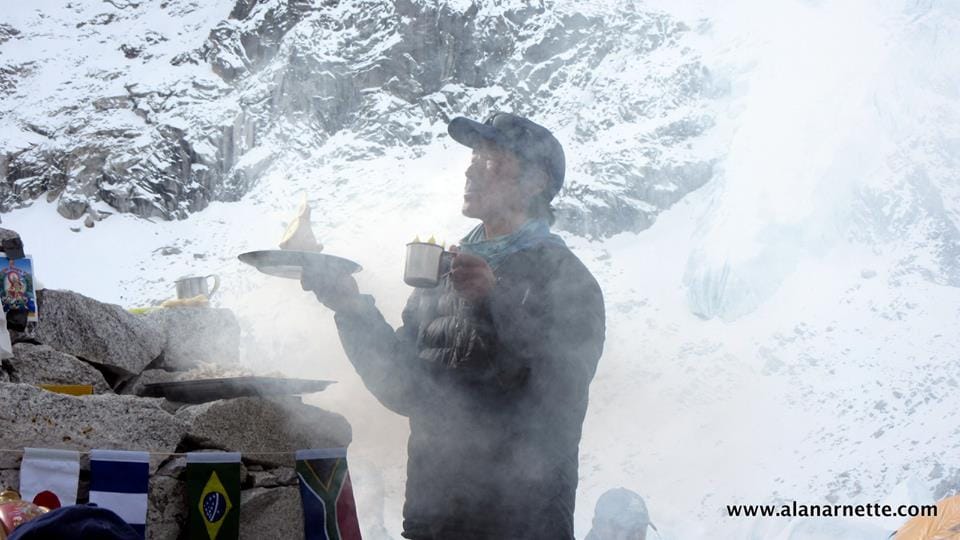
2014 continues to be a tragic year for those who love the mountains. In separate incidents over 24 people have lost their lives to avalanches, blizzards and heavy snow related to Cyclone Hudhud. Over 3 feet, 91 cm of new snow has fallen over two days.
The reports are still coming in so this is preliminary and guaranteed to change, potentially with significantly more deaths. The major incidents occurred about 100 miles or 160 KM northwest of Kathmandu in the Manang and Mustang districts. These areas are in western Nepal near the border with China and not near Everest or the Khumbu region.
Trekkers Die in Blizzards and Avalanches
Multiple news agencies are reporting on the deaths. CNN, and the Himalayan Tines, amongst others, are reporting that 16 people were killed by an avalanche on the high point of the Annapurna Circuit, the Thorung La pass at 17,769 feet or 5415 meters. The dead are said to include trekkers from Vietnam, Israel and Poland, nine Nepali. In a separate avalanche in the same area, multiple yak herders died one day earlier.
The trekkers were reported to be descending from the Pass towards Muktinath and were near Damcamp when the avalanche hit. Many of the trekkers have been evacuated via helicopter to Jomsom and over 100 trekkers have made it to the base of the pass at Muktinath. The rescued are reported to include five German, five Polish and four Israeli trekkers. Various reports estimate an additional 18 to 20 people are buried under the avalanche debris but there are reports of over 100 still missing. Keep in mind, there can be several hundred on the trails at any given time.
Apparently in a separate incident, four trekkers were killed when crossing the Thorang la pass. Only five bodies have been recovered: four Canadian trekkers and one Indian trekker. It is being reported that at least four of the deaths were the result of exposure during a blizzard and not from an avalanche those being two Polish, one Israeli and one Nepali from the Drump Camp.
Climbers missing in Avalanche
Separately, five climbers are missing from an avalanche at Mt Dhaulagiri Base Camp, two Slovakians and three Nepalis according to MyRepublica. Their names were released as Slovakians John Matik and Vladimir Syvansar and Nepali Bhoj Kumar Rai of Mauling-6, Okhaldhunga, Dorje Sherpa of Juling-2, Solukhumbu and Gopal Rai of Gudin-8, Solukhumbu
The heavy weather has caused delays for those still attempting climbs on the 8000 meter mountains: Makalu, Dhaulagiri, and Lhotse. There are no teams on Everest this autumn. Those climbs near Everest including Ama Dablam appear to have missed the brunt of the heavy snow.
Over 100,000 trekkers visit Nepal each year and October is generally consider safe with clear and stable weather.
My sincere condolences to the families of the d.
Contact for Families
There is a Facebook page to help families connect with those involved in the Annapurna Nepal avalanche & blizzard https://www.facebook.com/pages/Annapurna-Nepal-Avalanche-and-Blizzard-Info-Share/336895043154367
Oct 16, 2014 Update:
- Death toll from Nepal’s Annapurna region blizzard and avalanches now 27, with 70 more still missing according to authorities.
- 77 Trekkers evacuated from Nepal avalanche area via helicopters. 10 bodies recovered. http://taan.org.np/newsdetail/taan-rescues-77-from-manang
- Remember, those trekking in the Khumbu i.e. to Everest Base Camp or climbing Mera, Island, Ama Dablam, etc. were mostly unaffected by the heavy snows.
October 19, 2014 Update:
- 19 still missing in Annapurna area, hope fading
- but reports of people still stuck in teahouses
- Nepal Military continues to evac people via helicopters
- Sections of Annapurna Circuit closed by Nepal deemed unsafe and invisible.
- Death count now 39
Alan




10 thoughts on “Nepal Avalanches Kills Trekkers and Climbers in Seperate Incidents – Update 2”
Alan, I just got home from Ama Dablam. I left without attempting summit after a climber died with the fixed rope breaking during his rappel between camps 2 and 1. Any thoughts on the quality of rope used on Ama, and on the huge crowds there?
I am not sure what happened in this accident as new rope is normally put in and climbers should only be climbing and rappelling on the new line thus having a new fixed rope break is highly unusual. Of course if a new line was run over sharp rock edges, it can fray and break under a load.
Obviously It can happen if a climber uses an old rope that has been exposed to the sun’s UV rays for a while, it can be fragile and break easily under a strong load.
To your point on crowds, if everyone is jugging on a new line (or worse, an old one) attached to a weak anchor, that could also create a problem if the anchor gives way.
Bottom line is that each climber must take personal responsibility to use only a new line and never trust an old line, even if it is last season’s.
Hi Alan:
I have been following your posts re: Everest for years as my husband is a guide on E. Also, congrats on K2 with Garrett – very impressive. I have also been a supporter of your fight against Alzhiemers – as my Grandmother suffered and passed from this disease.
I am reaching out to you today — as my Mom was just diagnosed (on Friday) with Alzheimer’s. I was wondering if you could offer some advice? If possible, can we connect via email? I appreciate any guidance you could offer. My best,
Alan, thank you for this post and your updates. For new related to Nepal and big mountain climbs, I rely on your website for accurate, objective information. I know many others do as well.
Valerie Baker
Broomfield CO
Unfortunately it is sounding like many of these deaths were avoidable, caused by bad decision making and insufficient cold weather clothing and gear. For anyone thinking about doing a trip like this, I cannot emphasize enough that you need to be responsible for your own safety rather than simply trusting in a guide or trip leader. At minimum that means researching ahead of time where you are going each day, having a map/compass and knowing how to use them, and being prepared for any kind of weather. A trip up to these altitudes should never be thought of as “just a walk”. When I did my EBC trek last year my guide became seriously ill and had to discontinue. By being prepared, an event that could have been a trip-ender instead became an enjoyable few days exploring on my own while arranging with the company in Kathmandu for a new guide to meet me at my location (fortunately the first guide recovered and was doing ok the last I heard).
Whent we were there this time last year we caught the tail end of a cyclone in India, four people on the north side of Everest lost their lives (1x Australian and 3x Sherpa) and 120 were evacuated, we also heard of 15 people died because a roof collapsed due to heavy snow but it was never confirmed, and when we reached lukla another team were saying how they got caught up in avalanches and lost a yak (dzo) and another lost its horn and later had breathing problems, my thoughts to the families to the missing and fallen
No, or only one party on Everest, or Everest south side!? What’s going on? And what on the north side?
Facebook page to help families connect with those involved in the Annapurna Nepal avalanche & blizzard https://www.facebook.com/pages/Annapurna-Nepal-Avalanche-and-Blizzard-Info-Share/336895043154367
There has been one team on the Mt. Everest massif from the south side this fall, although their plan was only up to Camp 2 (6450m) and already called off after climbing up there.
Weather Gods this year have been severe. I hope we don’t see any other loss of life. Prayers for the families and friends of lost and missing.
Comments are closed.